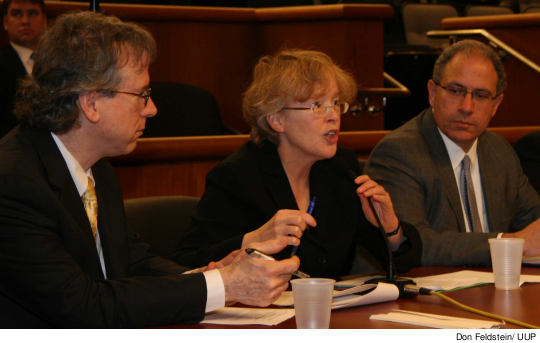 |
After three years of steady cuts to CUNY, the executive budget proposed by Gov. Andrew Cuomo in January would largely maintain current levels of State support. Cuomo’s budget would provide funding for CUNY’s mandatory cost increases – including maintenance of adjunct health insurance funding.
“The faculty and staff who work at CUNY are heartened that the governor has begun to stabilize CUNY funding by following through on the promise of a real maintenance of effort,” said PSC President Barbara Bowen at a February 1 budget hearing in Albany. “Now,” she said, “the legislature and the governor must begin the work of restoring CUNY funding, eroded by years of inadequate budgets.”
The start of this year’s budget debates saw a political opening for possible increases in community college funding. Assembly Speaker Sheldon Silver called for the State to increase support for the State’s community colleges as part of an initiative to help the working poor. Silver put a spotlight on the issue, identifying community college funding as a key issue of economic opportunity.
While welcoming these developments, Bowen noted that past cutbacks have put CUNY into a very deep hole: “The State must make new investments to reverse the decline caused by the last three years of austerity budgets, which cut $300 million from CUNY, and 20 years of disinvestment before that,” she said. And while the executive budget would “provide stability” for CUNY, she added, it still “relies too heavily on student tuition.” Bowen testified at a joint hearing of the State Senate Finance Committee and the Assembly Ways and Means Committee, where she and First Vice President Steve London represented the PSC.
A STEP FOR ADJUNCT CARE
In past years, the PSC and its allies have too often had to battle against executive budget proposals for deep cuts in State support, forcing CUNY supporters to run hard just to stay in the same place. “This year,” said London, “the governor provided funds for mandatory cost increases while keeping community college base aid funding and Tuition Assistance funding flat. Recent budgets have seen major decreases in the latter two.”
Its funding for mandatory costs means that Cuomo’s budget includes stable funding for the ongoing expense of health insurance for eligible adjuncts. “We ask for the legislature’s support in ensuring that this funding remains part of the final enacted budget,” Bowen said. This “will protect the health –and in some cases, the lives – of colleagues who do the majority of the teaching at CUNY.” (See page 2 for more.)
The importance of the community colleges for providing opportunity to the working poor was emphasized by Assembly Speaker Sheldon Silver in his remarks before the Governor’s State of the State speech when he said that Albany must do more. “With high unemployment and widespread underemployment, more and more of our citizens are looking to community colleges for a new path to a better life,” Silver said in a speech on January 4. “By law, this State is obligated to fund up to 40% of the operational budgets of our community colleges, but only once in four decades has the State fully met that obligation. Now, when these learning centers are so important to our economy, to our companies and to our workers, we must increase our investment in them.”
Silver was right on target, Bowen told legislators, on the growing role that community colleges are asked to play. In the first two years of the current economic crisis, CUNY’s community colleges saw their enrollment grow by 12%. “Yet as the pressure on these colleges has grown,” she said, “State support has shrunk.” The State has cut community college base aid three times, since December 2009 – a 24% decline.” This reversed progress on funding that had been made in the middle of the past decade, and contributed to moving community college funding in the wrong direction: a total 38% drop in State base aid for the community colleges since 1990-91.
RESTORE WHAT WAS LOST
To start repairing the damage, PSC leaders urged State legislators to restore community college base aid to its 2008-09 level, adjusted for inflation. London told Clarion, “that would set the rate per full-time-equivalent student (FTE) at $2,807, an increase of $685. For CUNY, this would add up to a total increase of $49.4 million in community college funds.” He added, “for those who think this is a lot to request in a tight budget it is simply the amount that has been cut from State aid to community colleges over the past three years.”
GOING HUNGRY TO LEARN
Senior college funding also needs to be restored, PSC representatives said. At CUNY’s senior colleges, State support per FTE at the senior colleges is down by almost 20% since 2008, and by nearly 40% since 1990. “The only solution,” Bowen argued, “is to reinvest public dollars in CUNY, and make a start in filling the hole left by more than 20 years of budget cuts.”
This is not just a story of numbers, Bowen emphasized. As a consequence of these cuts, she said, students “wait in long lines to use the handful of computer terminals in the library with Internet access, as they have no access at home.” Some are forced to wait a semester, or even a year, before they can get into a course without which they cannot graduate.
CUNY students may end up in a science lab course that enrolls 30 people – but only has 20 laboratory stations. “This means,” Bowen explained, “that a third of the class ‘completes’ an experiment without access to scientific equipment,” or gaining any hands-on experience. “As faculty and staff we do what we can to offset these results of austerity funding,” Bowen said. “But we know this is no way to run a university.”
Constant tuition increases cannot close this funding gap, Bowen told committee members. It would take thousands of dollars of increases in annual tuition to make up for decades of reductions in State support – and union leaders said this would raise tuition so high that CUNY’s ability to provide affordable, accessible higher education would be destroyed.
“While the governor’s proposed budget takes an important step toward stabilizing CUNY funding, it relies too heavily on increased tuition,” London told Clarion. At CUNY’s senior colleges, tuition has gone from 21% of funding in 1990 to 47% today. At the community colleges, it climbed from 22% to 42% in the same period. Yet thousands of CUNY students, including many of the very poor, are not covered by New York’s Tuition Assistance Program (TAP).
“It is a cruel and persistent myth that financial aid protects all low-income students from…tuition hikes,” Bowen said. “I can name several CUNY students who have told me they go to school hungry because they don’t have the money for both college and food.”
AN INVESTMENT FOR TOMORROW
Bowen thanked legislators for adding $9 million in funding for SEEK, College Discovery, and other opportunity programs when both houses came back for a special session in December, but she noted that without increased funding, CUNY plans to limit next September’s incoming class in both programs. In a broader sense, she argued, all of CUNY is an opportunity program – and one of the most effective ways that State dollars can be spent.
“No investment offers New York more benefit – economically, culturally, intellectually – than investment in public higher education,” Bowen concluded. It is time, she said, “to rethink higher education funding in New York State.”

